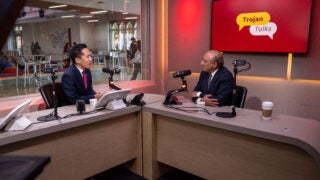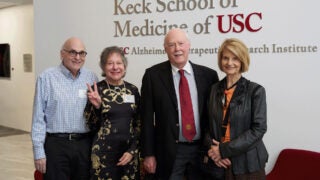Turn back the clock on aging
There’s no way to stop the march of time, but innovative research by USC scholars points the way to a longer, healthier and more vibrant life.
About 10 years ago, when George Salem was in his mid-50s, a friend invited him to play a round of golf. He accepted the invitation — even though the associate professor in the USC Division of Biokinesiology and Physical Therapy had never taken golf seriously. A former college football player, he favored more vigorous sports like snowboarding, basketball and rugby.
But when he joined his friend’s foursome, Salem found himself riveted by the action on the greens and fairways. The course was crowded with silver-haired players, many in their 80s and 90s. He struck up conversations with individuals who had survived cancer and strokes, undergone hip and knee replacements, and were grappling with Parkinson’s disease. And during play, these older golfers left Salem in the dust.
“I was amazed at how much better at golf they were than I was,” he says. “But more importantly, I was amazed at how they could get in and out of a sand trap, climb hills, track a ball and mentally strategize which club to use and how to shoot.”
An expert in exercise and aging, Salem wondered if golf itself was helping to keep these players physically robust and cognitively sharp despite their health challenges. Right there on the links, a new research direction was born.
For millennia, humans have been searching for ways to extend life and remedy the ravages of aging, pursuing mythical springs, miracle elixirs and science-based biohacks. In recent decades, as life expectancies have increased, the desire to thrive as we age has only intensified.
But quality-of-life challenges still loom for an older adult population growing at an unprecedented pace. This includes rising rates of age-related chronic diseases, social isolation and elder abuse.
Now an avid golfer and director of the USC Institute for Therapeutic Golf Science, Salem is among the many USC scholars in wide-ranging fields whose innovative research is meeting these challenges head-on — and redefining the path to longevity in the process. Whether leveraging science and technology or harnessing the power of community, USC researchers are making leading-edge discoveries that can guide the choices we make today for a healthier and happier tomorrow.
“USC is uniquely positioned to chart new territory in our understanding of longevity and healthy aging,” says Pinchas Cohen, dean of the USC Leonard Davis School of Gerontology, which is the nation’s first and largest educational institute on aging. “We are unmatched in our constellation of resources to support patients, families and caregivers and develop visionary new ways to increase both lifespan and healthspan — years spent free of disease.”
You Are What You (Don’t) Eat
THOUGH THE PASSAGE of time is a constant, the rate at which we age varies from one person to another.
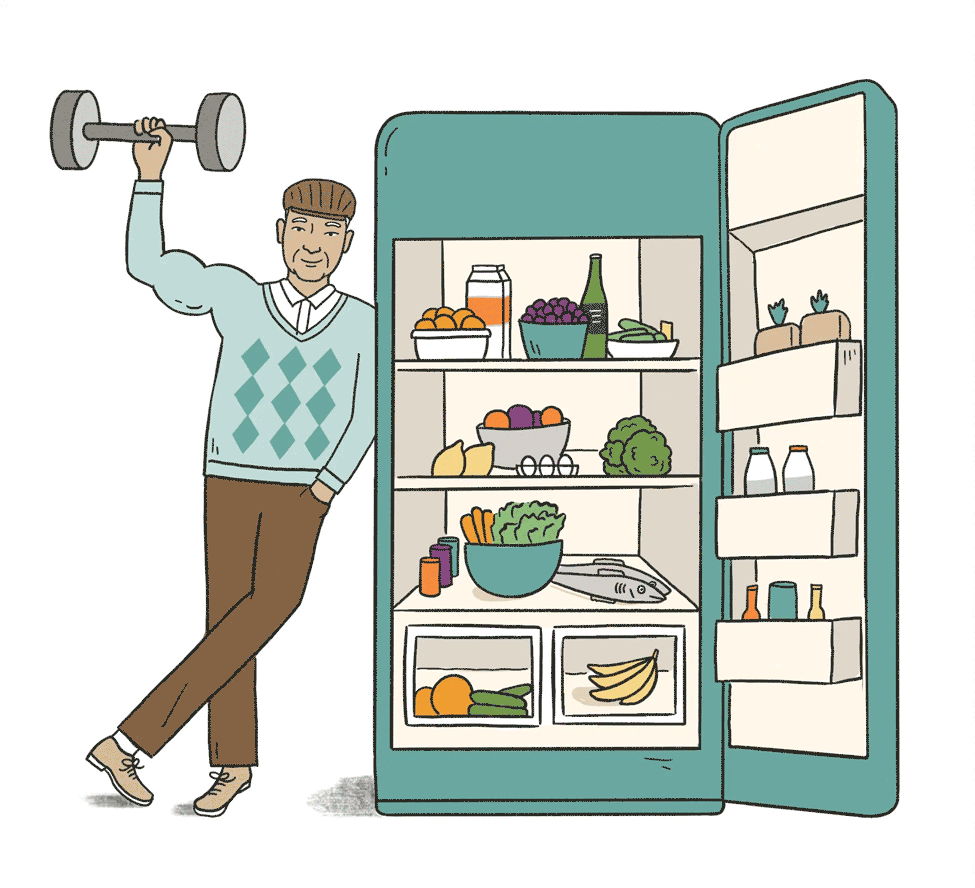
Scientists make a distinction between your chronological age and your biological age, the latter being a measure of the functional state of your body’s systems and damage that’s occurred to your cells and tissues. If your biological age is greater than your chronological age, you’re more likely to develop age-related diseases including dementia, stroke and more. While genetics influence the pace of biological aging, making healthy lifestyle choices can slow it down — or possibly put it in reverse.
One of the most important choices is what you put on your plate. Exploring a century of research on long-lived populations around the world, Valter Longo, professor of gerontology and biological sciences at USC Leonard Davis, developed recommendations for a “longevity diet” that is rich in legumes, whole grains, vegetables, nuts, olive oil and some fish, and low in red and processed meats, sugar and refined grains.
But his research also demonstrates the benefits of taking breaks from eating abundantly. A recent study Longo conducted with Sebastian Brandhorst, associate professor of gerontology, and other collaborators reveals that periodically adopting a “fasting-mimicking diet” (FMD) — which contains ingredients that simulate fasting and drastically limits calorie intake for five days — can shave years off your biological age. In the study, adults who completed three FMD cycles over several months slashed their biological age by an average of 2 1/2 years, and their insulin resistance and other pre-diabetic markers improved.
“Humans and many other organisms evolved during long periods when we didn’t have food,” Longo says. His lab’s animal studies suggest that when our hunter-gatherer ancestors feasted after a period of famine, a process called cellular reprogramming kicked in so that shrunken cells, organs and tissues could be rebuilt and restored. “The fasting-mimicking diet is tapping into this ability of the system to detect damage and then begin a process of self-repair and regeneration,” he says.
Longo has shown that in mice, periodic FMD cycles reduce harmful inflammation, kill cancer cells and improve markers of Alzheimer’s disease in the brain. Early research suggests they may do the same in people. Longo’s discoveries have been leveraged by his company L-Nutra to create FMD kits for general health and tailored to specific diseases including diabetes, cancer and Alzheimer’s.
Teeing Up for Play Time
OUR PREHISTORIC predecessors’ survival depended upon physical fitness, as hunter-gatherers had to outrun predators and prey. Now, if we hope to outrun age-related diseases, staying active is vital.
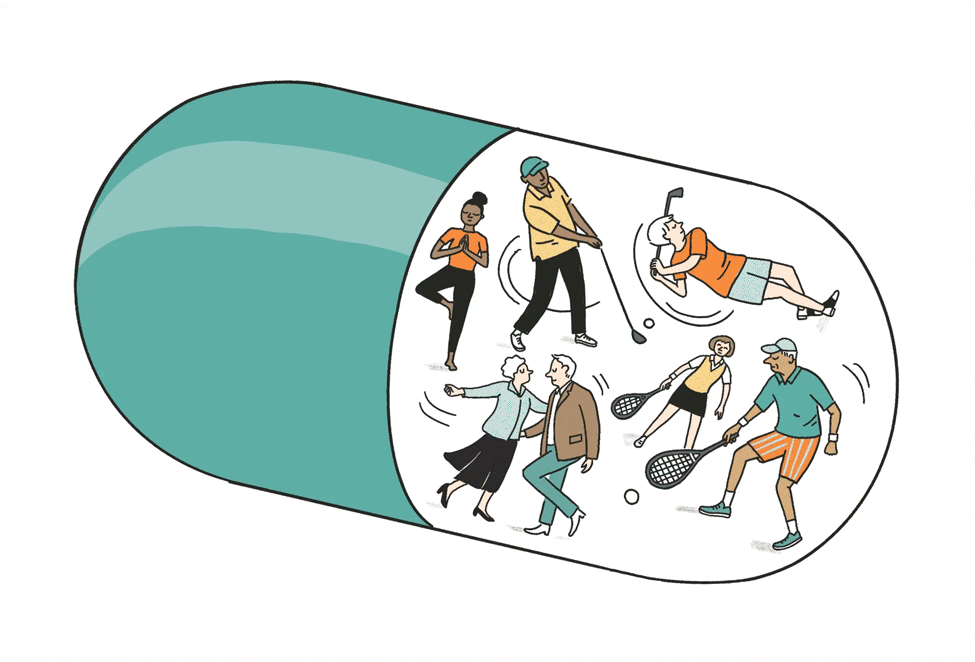
“Exercise is the magic pill,” says George Salem, noting that regular physical activity improves sleep and immunity, bolsters brain health and mental health, and decreases the chances of dying from any cause.
Over the past decade, Salem has conducted a series of studies on older adults, including veterans and prostate cancer survivors, who learn to play golf. He’s shown that in as few as 10 weeks, participation in the sport — which gets players striding up and down inclines and squatting to place and recover balls — increases walking ability and balance, improves performance on cognitive and memory tests, and reduces blood markers of inflammation.
The mental and social aspects of golf contribute to these benefits. As golfers strategize shots and fraternize with their peers, they’re stimulating their brains and engaging in what keeps Salem himself committed to the sport: play. “It’s more fun to play than it is to exercise,” he says.
Many of the participants in Salem’s studies express a desire to continue golfing after the introductory lessons end. “Once you’re hooked, you’re hooked,” Salem says. “Golfers will go out in the pouring rain and out in the snow. They show up because they’re playing with friends who expect them to show up.”
That level of investment in a fitness-boosting activity may help explain why golfers live five years longer on average than nongolfers. But if teeing off isn’t your cup of tea, don’t despair. “Other recreational activities, including pickleball and ballroom dancing, are likely just as beneficial,” Salem notes.
Ready, Tech, Go!
NO MATTER HOW physically fit you are, sedentary behavior poses a significant threat to longevity. Sitting for long periods of time without breaks has been linked to a higher risk of heart disease, diabetes, cancer and death — even among those who exercise. Older adults with mobility issues, chronic pain and other health conditions are especially vulnerable to sitting for hours upon end.
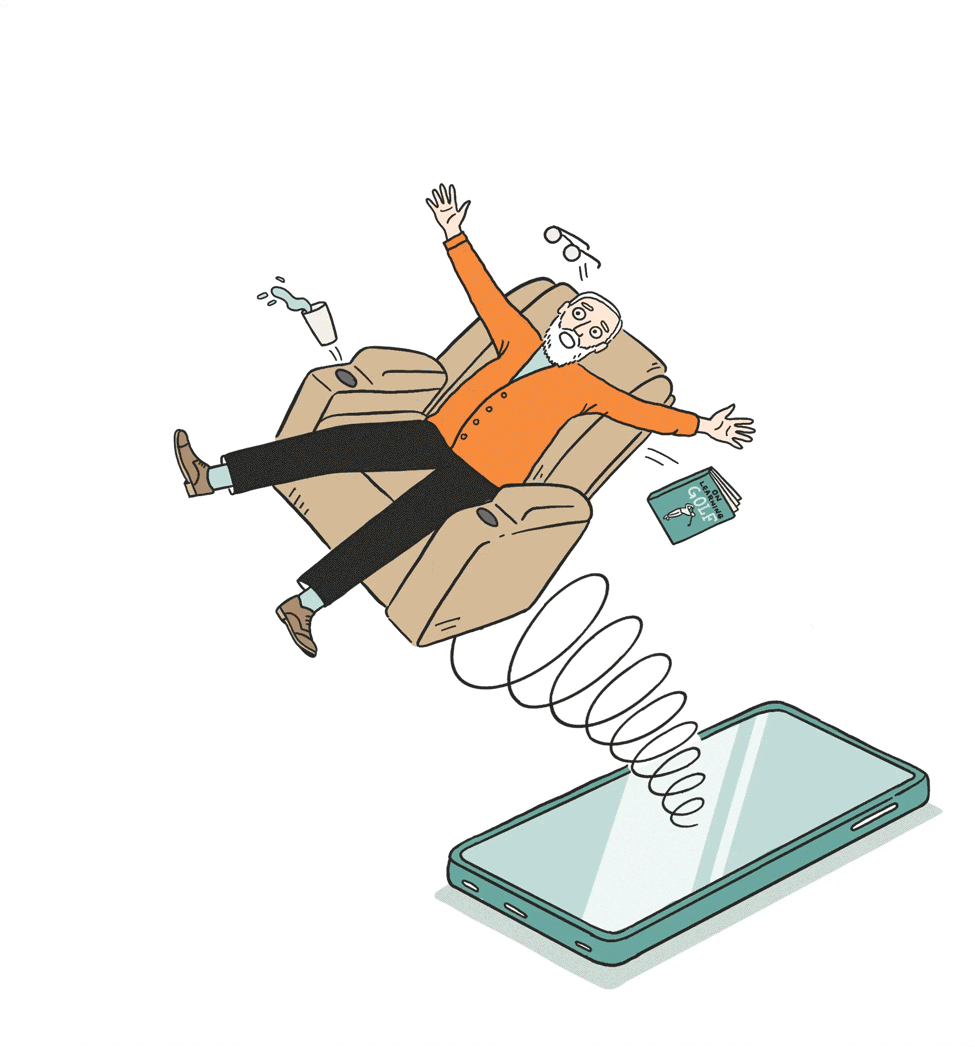
At the Healthy Aging Research and Technology Lab in the USC Mrs. T.H. Chan Division of Occupational Science and Occupational Therapy, Stacey Schepens Niemiec, associate professor of research, is developing new tools to help older people reduce their amount of sedentary time. These tools incorporate both low-tech and high-tech solutions.
One is a smartphone app called Moving Up that tracks the number of hours users spend immobile and offers customized suggestions for integrating more movement into their self-reported activities. For example, if the user is watching television, the app may alert them to drink more water — not only for extra hydration, but to encourage more frequent walks to and from the bathroom.
Schepens Niemiec is also collaborating on the development of an active seating system that incorporates pedals — like a stationary bike, but without wheels — and sensors that track seated time. The system prompts users to pedal for a couple of minutes at regular intervals to counter the negative side effects of long periods of immobile sitting like stiffness and reduced blood flow.
It may seem against the grain to develop technological solutions for an older population, given that younger consumers are more often the assumed end users of the latest tech. But Schepens Niemiec is aiming to fill a gap. “The older adult population tends to get overlooked when it comes to tech-driven innovations,” she says. “Right from the start, I get older adults’ input in the design of the technology to help make it more accessible to them.”
Now Hear This
ONE TECHNOLOGY for older adults that has greatly advanced in the past decade is hearing aids, which are smaller and have better sound quality than the devices of yesteryear. Yet only one in 10 of the approximately 40 million American adults who need hearing aids use them — likely due to a variety of factors, including cost and social stigma.
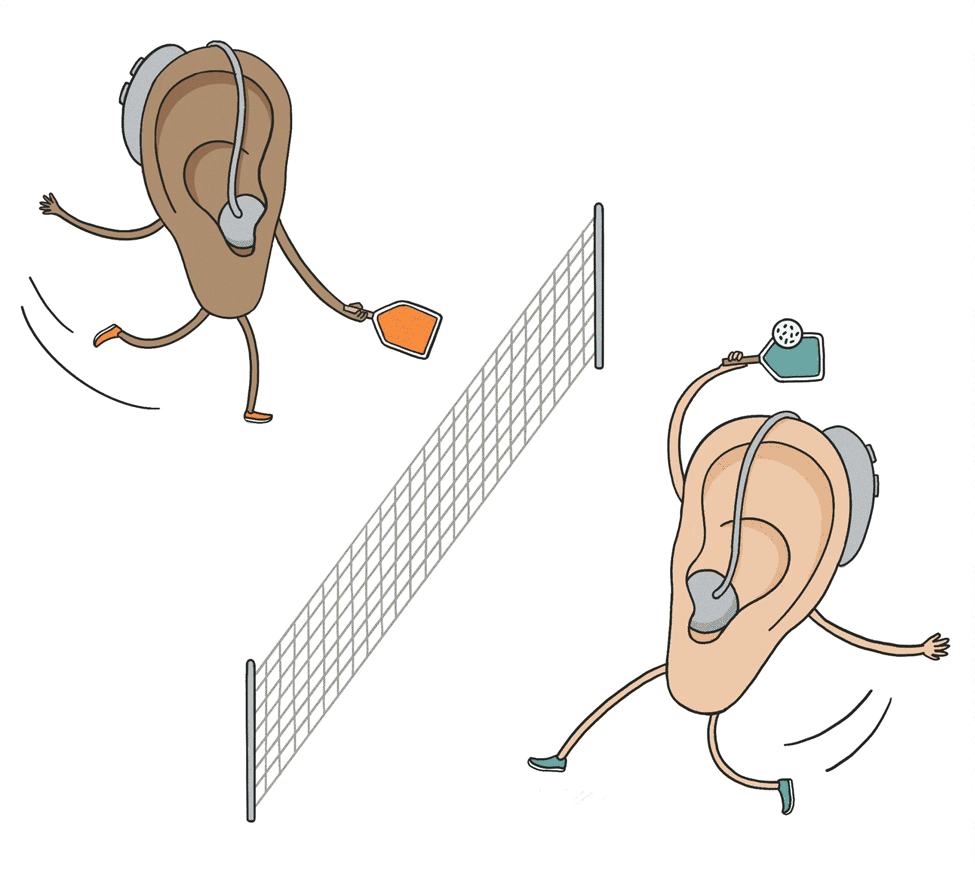
“A good number of patients tell me, ‘I don’t want to look old by wearing hearing aids,’” says Janet Choi, an otolaryngologyist with Keck Medicine and assistant professor at the Keck School of Medicine of USC.
That mindset can be self-defeating — because using hearing aids may help you live longer. Groundbreaking research by Choi and her collaborators revealed that among those with hearing loss, regular hearing aid users are almost 25% less likely to die from any cause than those who never wear them.
Though more research is needed to untangle why hearing aid use boosts lifespan, it’s possible that it confers protection against diseases linked to untreated hearing loss, including dementia and depression. “Some studies suggest that the sound input provided by hearing aids may have a positive impact on brain structures,” Choi says.
Choi is now researching ways to encourage hearing aid use among older people and counter social stigma associated with the devices, which she relates to from personal experience. The specialist in ear-related disorders was born with hearing loss in her left ear and now wears a hearing aid. But she didn’t do so as a child because her parents were worried she would be ridiculed at school.
It took Choi three tries before she found the right hearing aid for herself. Knowing that the time-intensive selection process can be a barrier to use, she’s developing an AI-driven database that helps match patients with hearing aids best suited to their unique needs.
Shore Up Support
WHEN OLDER ADULTS with hearing loss adopt hearing aids, they’re better able to participate in conversations and stay engaged socially, buffering themselves from isolation. That itself may boost longevity: Feeling isolated makes it more likely you’ll develop dementia, depression, heart disease and stroke, and die prematurely.
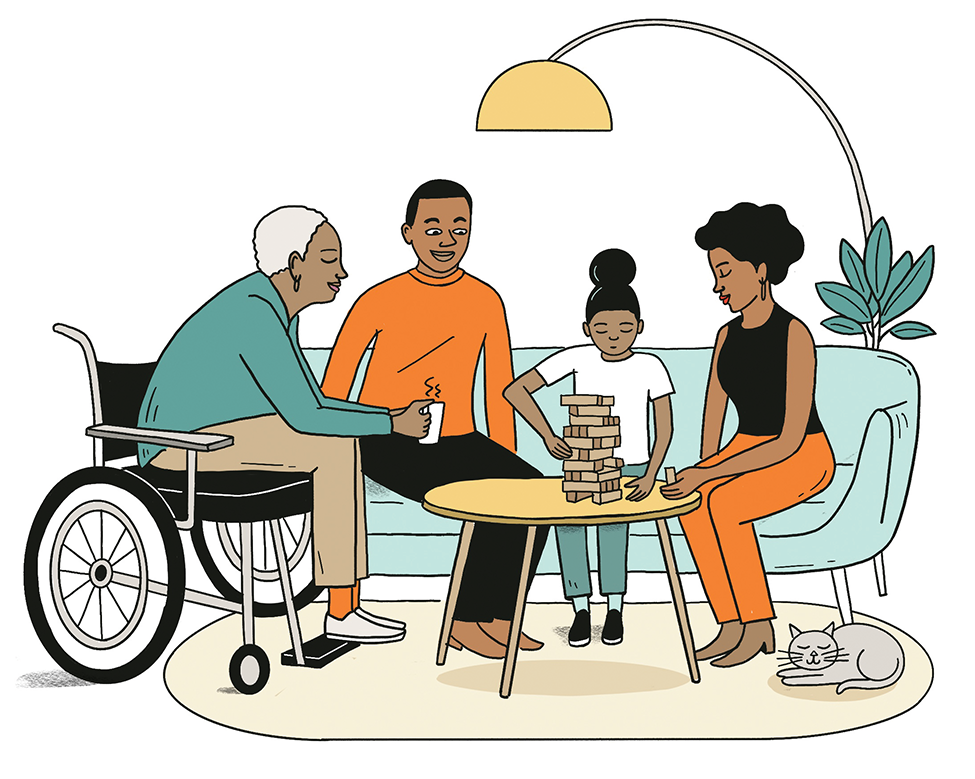
Interdependence with others is critical throughout our lives. But as we age and need help with the tasks of daily living, interpersonal dynamics shift. Our adult children or spouse may step in to take care of us.
“That can be a wonderful new opportunity for a deepening love,” says Laura Mosqueda, professor of family medicine and geriatrics at Keck School of Medicine. “And it could also be an opportunity for abuse or neglect.”
One in 10 older adults is abused or neglected in their lifetime, and among those with Alzheimer’s or other dementias, the rate jumps to nearly one in two. Most commonly, the person carrying out the abuse is a close family member.
In her research on the causes of elder abuse, Mosqueda has found that abusive behavior is often rooted in caregivers’ difficulty coping with their demanding roles. “Eighty percent of abuse and neglect is preventable,” she says. “We need to look for the early warning signs: caregivers who are stressed, resentful, burdened and unhappy.”
Along with her collaborator Bonnie Olsen, professor of clinical family medicine and vice chair for research at Keck School of Medicine, Mosqueda is investigating how best to detect these signs and intervene by equipping caregivers with tactics for elder care and self-care. They’re one of several teams at USC working to support caregivers’ well-being and, by extension, the well-being of the older adults in their care.
At the USC Family Caregiver Support Center (FCSC) directed by Donna Benton, associate professor of gerontology, innovative research includes studies on how best to support dementia caregivers and how technology can improve caregiving. The FCSC also runs support groups and helplines for care-givers throughout the Los Angeles area, with groups such as the one at the First AME Church near the USC University Park Campus supporting diverse and low-income communities.
Tapping into the power of community to ease the challenges of modern aging is also a focus for María Aranda, professor in the USC Suzanne Dworak-Peck School of Social Work and director of the USC Edward R. Roybal Institute on Aging. Aranda conducts intervention research with English- and Spanish-speaking caregivers in the communities surrounding USC and has found that family caregivers of loved ones with medical conditions feel less alone in their journeys when they join supportive groups and share resources. Older adults who nurture community connections fare better, too, given the increased sense of purpose and emotional attachments.
“Whether it’s leisure activities, social activities related to their house of worship, or relationships with family, friends or neighbors, people who have a sense of purpose and meaning are likely to have a longer and more enjoyable life,” Aranda says.
Her insights affirm what Salem observed that pivotal day on the fairway. Social connectedness is a driving force of human thriving — whether on the golf course or over the course of a life well-lived.
Your Cells on Aging
Inside your body’s cells, structures called mitochondria create the energy needed to carry out vital life processes. Cellular aging begins in these power houses. “Mitochondria are the first part of our cells to experience dysfunction as we age,” says Pinchas Cohen, dean of the USC Leonard Davis School of Gerontology and Distinguished Professor of gerontology, medicine and biological sciences.
Cohen and his collaborators have identified a series of microproteins produced by the mitochondria that naturally decrease with age and whose decline is linked to the onset of agerelated diseases. His lab’s remarkable discoveries include mitochondrial microproteins that protect against Alzheimer’s disease, Parkinson’s disease and diabetes, and are associated with longer life spans.
To sustain life, cells rely on a set of chemical reactions known as cell metabolism, which produces substances called metabolites. Peter Mullen, assistant professor of molecular microbiology and immunology at the Keck School of Medicine and USC Leonard Davis, along with his collaborators, have identified multiple metabolites in the organs of mice that decrease significantly with age and whose reduction is associated with organ dysfunction. Many of these metabolites can also predict biological age in humans.
Both mitochondrial microproteins and metabolites have the potential to become tools of “precision longevity.” They may one day form the basis of drugs tailored to the specific cellular deficiencies of each individual to treat disease and prolong life. — Rachel B. Levin



